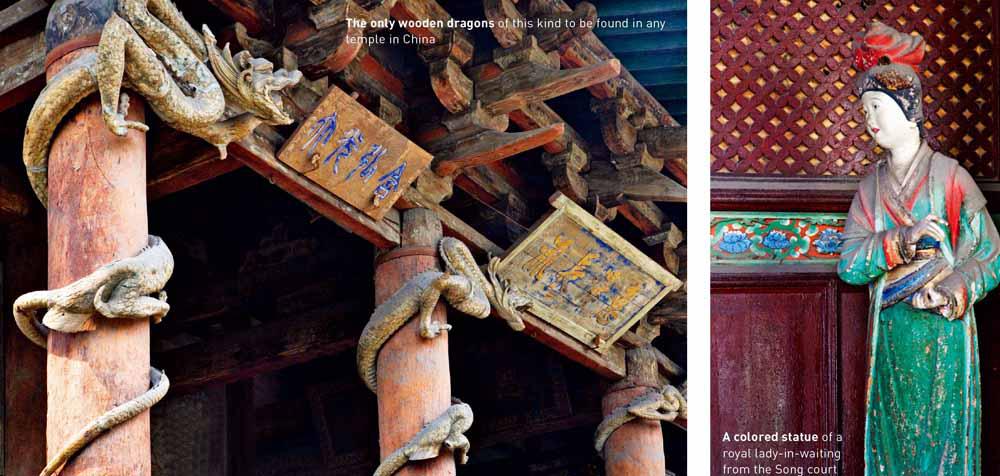TAIYUAN END URES
2016-01-10刘珏
刘珏



A magic fountain, twin pagodas, and a legacy of imperial might—all in a third-tier city
这座看似平凡的古城之中,
有难老泉的神秘传说,
永祚寺的巍峨双塔,
还有说不完的历史掌故
At first glance, Taiyuan (太原) may not seem to be of any special importance, just your bog-standard Chinese third-tier city. But, it was once a seat of power that held the key to ruling North China. Today, relics and natural wonders have seen their way through the past and sit hidden in this quaint industrial city. The capital of Shanxi Province, Taiyuan is driven by coal, and not long ago, it was among the most polluted cities in China. With new measures it has gotten better—though still not ideal. Its just three hours by high-speed train from Beijing.
While industry may have made Taiyuan a less than attractive destination for tourists, its past as the capital and secondary capital of many dynasties is a testament to its historic value, going as Jinyang (晋阳) in the annals of history. The earliest reference of the city appeared over 2,500 years ago. Its strategic location provided for a fort to protect against the nomadic invaders in the north. The city exerted immense political, economic, and cultural influence throughout northern China. And, as gods, kings, and emperors fought for what is now Taiyuan, its reputation as a seat of power truly made it the “Dragon City”.
After more than a millennium as a gem of the North, in the tenth century, Emperor Taizong of Song conquered the city and, fearing a rival force, ordered the city be burned in 979. But the city would not stay destroyed; in just three years, the city shifted a few kilometers north and became Taiyuan.
Today, when you arrive at the city, you wont see the flames of battle or the glory of a northern capital. Stepping off the high-speed train in the brand new south station, you can take a cab to the downtown area for only 20 RMB, but youll probably want to go right ahead to the most recognizable symbol of the city: the Twin Pagoda Temple (雙塔寺).
Situated on a small hill on the southeast of the city center, the temple is officially called Yongzuo Temple (永祚寺), meaning “the temple of everlasting bliss”. Auspicious as it sounds, the locals prefer to name it after the iconic twin pagodas, part of the citys official emblem. First built in the late 1500s, the temple was rebuilt and repaired over the years. You should plan to visit at noon, the least crowded time of the day, giving you the chance to stroll peacefully among some of the Norths most impressive architecture.
But, even this temple is a remnant of war. Just 68 years ago, during the Civil War, the temple was used by Kuomintang troops as a reinforced stronghold. During the final stages of the war between the Communist Party and the Kuomintang in 1949, the most brutal campaign took place in Taiyuan, a siege that lasted for over six months and claimed more than 175 thousand casualties. Traces of the battle have been wiped clean.
Upon entering the courtyard, you find a vast garden with distinctive northern features: pine trees and peony flowers. Long corridors dotted with lanterns form a quiet environment for Buddhist learning.
The main trail takes visitors to the temple hall, where ceremonies are usually held. Built with black bricks, instead of the wood that so often appears in the southern temples, the main hall is a two-storey building that houses the Buddha Amitabha. At the turn of the 20th century, German architect Ernst Boerschmann made a trip here and photographed the hall, providing the earliest shot of this structure in history and an interesting window into China at the time. It is, however, surprising how little has changed; the only differences from those black and white images are the two pine trees on each side of the hall—once thin and bare, now flourishing and robust. The brick hall stands—after all those bullets, mortars, and death—unchanged and relatively undisturbed by the upheaval of the last century.
Moving southeast, a terrace opens up where one can see the famous Twin Pagodas. Both of these pagodas are 13-storey, octagonal brick structures standing over 50 meters tall. However, “twins” is perhaps a bit of a misnomer.
These two structures were built for entirely different purposes. The pagoda on the east, built in 1608 by local gentry, was to bring luck to the citys examinees for the imperial examination based on the beliefs of fengshui, with modern hopes that it still stands true for the equally important gaokao today. The pagoda on the west built nine years later by Buddhist monk Fudeng from Mt. Wutai was to house holy relics of the Buddha. Sans the relics, the west pagoda is open for the public. Its a hard climb inside with dim light and steep stairs. Four windows were installed on each level but because this was meant as a storage space for artifacts, they are so small that you have to kneel to get any kind of a view. For curious souls, it is a climb worth taking. On the way up, visitors will find inscriptions of names and little hearts carved on the brick walls, a favorite, though somewhat disrespectful, pastime of young lovers.
In any case, the best viewpoint for the Twin Pagodas is at the Garden of Ink, or “Mo Yuan”, on the east side of the terrace. Together with the greenery, pavilions, long corridors, and moon gate, the pagodas stand against the blue sky (pollution permitting) to form a lasting memory.
For lodging, its hard to beat anywhere near Wuyi Square (五一廣场), which boasts ample accommodations and, of course, restaurants. Visitors should definitely be sure to check out some of the Norths famous varieties of noodles.
After a hearty meal, if you want a spot to chill, give the coffee shops a miss and head for the northwest corner of the Wuyi Square by Qifeng Street for Chunyang Palace
(纯阳宫), a Daoist temple that houses LüDongbin (吕洞宾), the Daoist grandmaster. Its a traditional courtyard with halls and corridors covered by layers of green and rockery. Only 100 meters from the bustling city square, inside the peaceful palace, one is filled with serenity.
But, all of this is just skirting around what visitors come to Taiyuan to see: Jinci Temple (晋祠). The other sites were just a short cab ride away, but this one will take some traveling. You can drive for about 40 minutes if youre in a hurry, or you can take a bus, which is very convenient but can also double your travel time.
As history fans will already know, Jin (晋) is an alternative name for Shanxi Province because, in the Spring and Autumn period (770 BCE – 476 BCE), most of what is now Shanxi belonged to the state of Jin. The temple itself was built to honor the founder of the state, Shuyu (叔虞). Interestingly, he got it because a young king got cocky.
As the younger brother of King Cheng of Zhou (周成王), Shuyu was playing with the king one day when they were kids. King Cheng cut a piece of leaf into the shape of a jade symbol representing power and gave it to Shuyu, saying: “With this token, I grant you a piece of land.” The regent, the Duke of Zhou (周公), heard this and asked the king if he meant it. The king replied by saying he was only joking. The duke told him: “The king can not be frivolous with his words. Anything he promises will be recorded by the historian, and it will be implemented with the right etiquette and music will be played to honor it.” So, the king kept his word and granted Shuyu the land he was promised.
Jinci Temple became a sort of architecture project through the dynasties. Today, you will find an extensive complex of buildings with pagodas from the sixth century, inscribed steles from the seventh century, a main hall from the 11th century, and pavilions and opera stages from the 15th century, and structures from more recent times like the park around it. This is the type of place youll need a whole day to appreciate, and the audio guide will help you with your history.
The crown jewel of Jinci Temple is its main hall, Saint Mothers Hall (圣母殿). Built in honor of the mother of Shuyu and King Cheng of Zhou, this hall is a millennium-old wooden structure that stands almost 20 meters tall. Eight wooden dragons intertwine on the front pillars of the hall, and this is the only ancient example of this type of art in existence. Walking around this solemn structure, you will find skillfully crafted wooden fittings that show no sign of weakness even after a thousand years of war, wear, and tourists—a true wonder of ancient architecture. Inside the hall is something equally precious, a range of thousand-year-old colored statues forming the royal court with the Saint Mother sitting on her throne decorated with carvings of phoenixes. Her ladies-in-waiting, eunuchs, maids, and entertainers are adorned throughout the hall, all with specific, life-like details that seem to tell their own story.
The lands to the south are nurtured by the Jin River, and the Jinci Temple is where that river begins—literally inside the temple. The famous Nanlaoquan (难老泉) spring, or “the spring of lasting youth”, can be found west of the main hall, featuring a series of pavilions, bridges, and buildings marking the area. Visitors usually like to get close to the water and fill their bottles, cheerfully splashing one another with the crystal-clear spring water. As with pretty much every scenic spot in China, it wouldnt be complete without a folk story. Legend has it that a kind-hearted young woman had to fetch water from so far away that a round trip took an entire day. But she always conceded to an old mans pleas for a drink for his horse on her way home. You have probably already guessed that this was no ordinary old man. He was a god. He gave her a horsewhip that automatically filled the urn when she whipped it so she never has to fetch water again. Her evil mother-in-law discovered the secret and misused the whip, causing the village to flood. The young woman made amends by sitting on a lid over the urn, resolved never to move. The flood then turned into a babbling spring. Today, you will find the Water Mothers Building (水母楼) behind the spring with the womans statue inside. Legends like this abound in the temple.
Despite its past suffering, there is a great deal more to see in Taiyuan: the Tianlongshan Grotto (天龍山石窟) with Buddhist figures and murals, the Shanxi Museum filled with national treasures, the Donghu Vinegar Garden (东湖醋园) that will leave you wanting more of this local delicacy. War and chaos are no more, but new threats still loom. The fast pace of development has a price, and for now that price seems limited to the skies. Will the city survive the pollution of modernity to thrive once again? Only time will tell, but this city has been burnt to ash, seen emperors come and go, and has been an important seat of power for longer than its oldest buildings. It, once again, will watch the world change around it.
